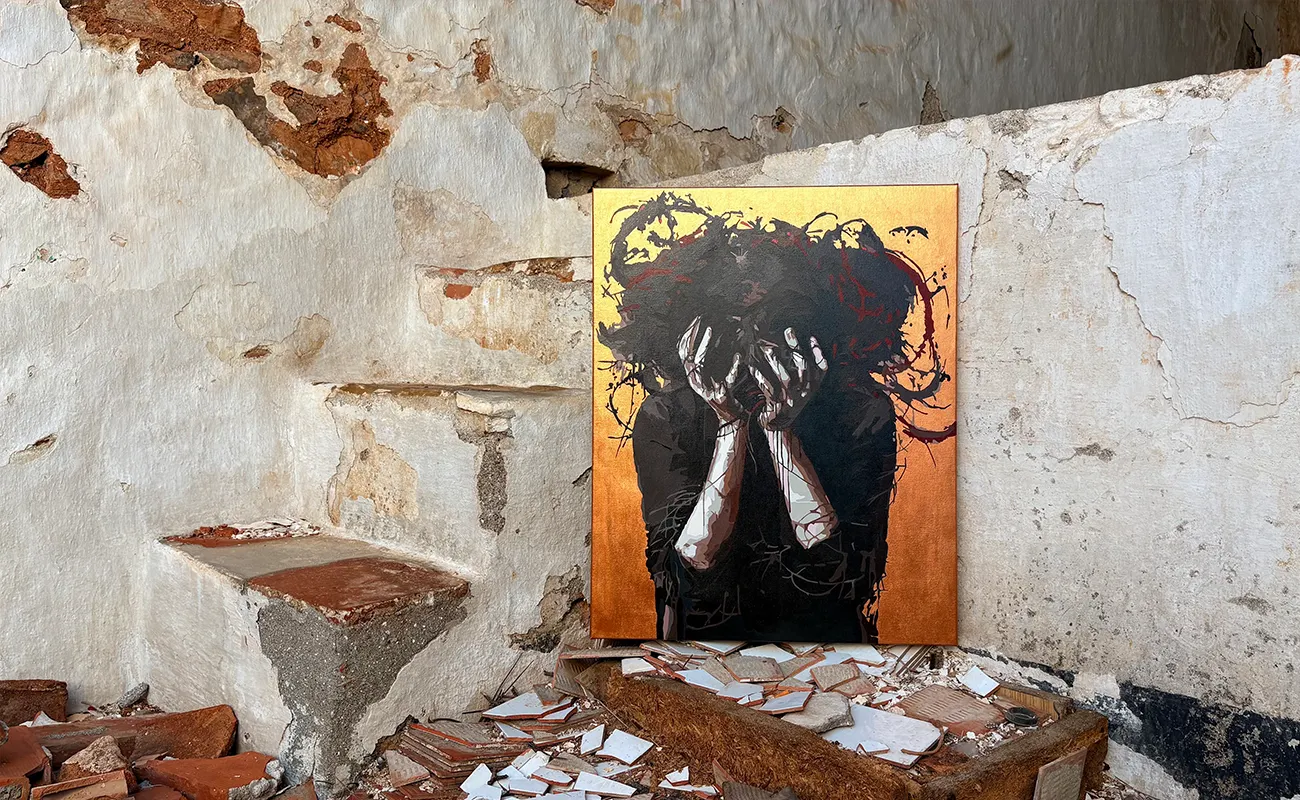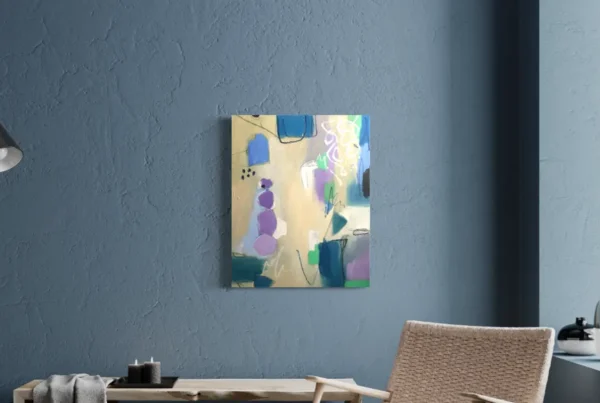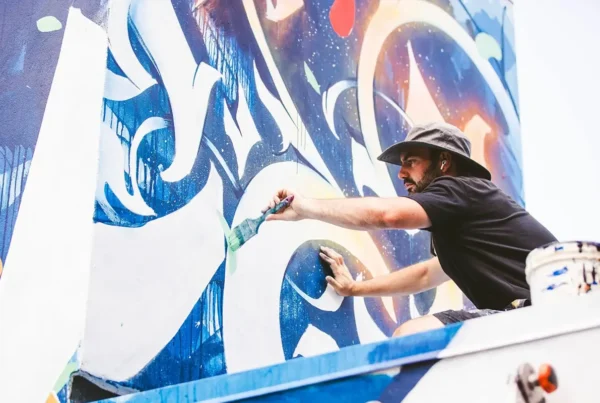“‘Despair’ became a reflection of the state I was going through: feelings of loss, fear of the future, but also the realization that from this abyss, a way out could be found.”
A Private Cosmos: The Solitude Behind the Canvas
In a world saturated with noise and digital distractions, Alisa Chernova has crafted a different kind of space—one where silence is sacred, solitude is empowering, and inspiration comes not from crowds but from clouds. Nestled within a compact yet warmly arranged studio, she has established a sanctuary entirely devoted to introspective creation. This is not merely a workspace but a vessel for mental clarity, a zone where external interruptions are consciously muted. Rain often serves as an unexpected muse, its rhythmic patter amplifying the atmosphere of deep focus and offering a soothing soundtrack to her internal dialogue. Rather than relying on constant stimulation, she finds creative sustenance in the stillness, allowing her mind to navigate the layered dimensions of emotional complexity that characterize her art.
Music, when introduced, acts not as a distraction but as a quiet collaborator. Depending on the emotional landscape of the day, Chernova turns to the baroque intricacies of Bach or the expressive tones of jazz, crafting an ambient rhythm that aligns with her painterly intentions. This auditory backdrop acts like a scaffold, supporting rather than overpowering the intensity of her concentration. Music becomes an invisible partner—offering cues, establishing mood, and guiding her brush through the tangled corridors of human emotion. Far from being just an aesthetic preference, these sounds serve a therapeutic purpose, gently lifting the veils of memory and internal struggle that inform much of her subject matter.
Chernova’s commitment to creating in a controlled environment reflects the broader philosophy that infuses her practice. The silence and solitude are not only preferences; they are essential tools in a psychological and artistic process designed to confront, analyze, and transform. Each piece emerges from this meditative state, where the mind is allowed to fully encounter its darker recesses. Rather than resist these emotional undercurrents, Chernova welcomes them, channeling them into bold compositions that explore the weight of sorrow, the pressure of anxiety, and the delicate thread of hope. Her studio becomes more than a physical location—it is a conceptual womb where vulnerability is examined and ultimately reborn as visual expression.

Alisa Chernova: From Exile to Expression
The painting Despair stands as a cornerstone of Alisa Chernova’s creative and emotional evolution. It was not born from theory or aesthetic ambition but from the raw immediacy of personal loss. Forced to abandon her homeland due to the war conflict in Donbas, she experienced a devastating rupture—leaving behind not only her home but her profession, community, and sense of belonging. Relocated to a foreign country with an unfamiliar language and culture, she found herself submerged in isolation and uncertainty. During this turbulent period, painting became more than a form of expression—it became a mechanism for survival. Despair captures that internal collapse, the emotional paralysis of grief, and the slow, painful reconstruction of identity through artistic introspection.
Beyond its autobiographical roots, Despair functions as a universal testament to the emotional toll of displacement and trauma. The composition articulates the claustrophobic sensation of losing control, the narrowing of perception when hope seems inaccessible. The painting is steeped in psychological nuance, reflecting not just fear of the unknown but the fatigue that comes from carrying invisible burdens. Yet embedded within the visual chaos is the faint, flickering outline of resilience. This duality is what gives the work its power—despite its somber tones, it points toward the possibility of renewal, suggesting that even within the darkest void, there exists the capacity for light.
Today, Despair is not just a reflection of a past chapter but a pivotal milestone in Chernova’s transformation from medical professional to therapeutic artist. It symbolizes a profound metamorphosis—one in which vulnerability became strength, and crisis became catalyst. Now part of her conceptual series In the Company of Sigmund Freud, the painting marks the beginning of her mission to explore emotional extremes through symbolism and color. It remains a deeply personal touchstone but also a point of entry for viewers seeking to understand their own psychological landscapes. Through this piece, Chernova not only shares her story but opens a doorway for collective healing.
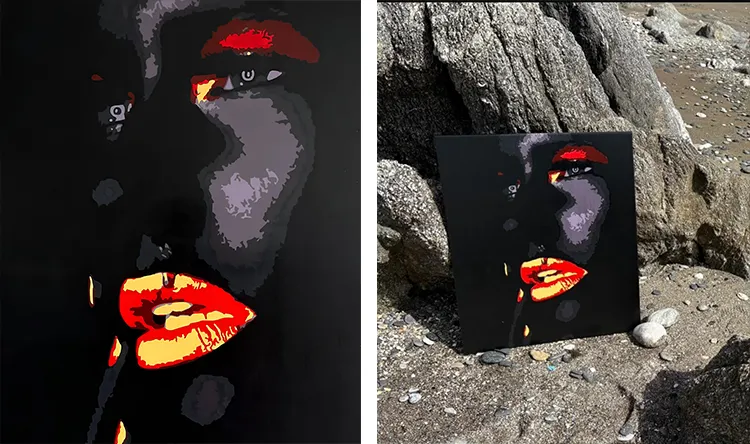
Symbols in Motion: Where Thought Travels
Alisa Chernova’s creative process is deeply intertwined with movement, both physical and intellectual. Her preference for solo travel is not merely recreational; it is a form of active reflection, a roaming meditation that feeds her artistic intuition. In quiet towns and open highways, she finds mental spaciousness that urban life cannot provide. One defining experience occurred in Kaunas, Lithuania, where she encountered the work of Mikalojus Čiurlionis at a local museum. His painting Rex left an indelible mark on her psyche. The piece, infused with mysticism and philosophical inquiry, depicted a monarch whose power is overshadowed by an unseen, controlling force—a metaphor that resonated deeply with Chernova’s understanding of emotional repression and autonomy.
What captivated her about Rex was its duality: the king sits on a throne, enrobed in luminous garments, yet a shadowy figure looms behind him, guiding his fate. This contrast between external authority and internal captivity struck a chord, reflecting her own ongoing inquiry into the psychological forces that shape human experience. The symbolism of the painting served as a mirror, echoing themes of solitude, control, and existential yearning that she herself explores in her own body of work. It wasn’t simply admiration for a fellow artist; it was recognition of a shared language, one spoken not in words but in forms, textures, and emotional gravity.
These travels, whether through foreign cities or remote mountain roads, are more than escapism; they are essential recalibrations. When creative fatigue sets in, Chernova doesn’t retreat to a desk or sketchpad; she gets in her car and drives. Winding through alpine roads or walking along stormy coastlines, she reconnects with the natural elements that stimulate emotional renewal. Coffee in hand and classical music in her ears, she sits at the edge of the world—not to capture it with a lens, but to absorb its magnitude. This ritual is not about visual documentation but emotional recalibration. It is here, among the clouds and crashing waves, that her ideas incubate, where silence once again clears the way for imagination.
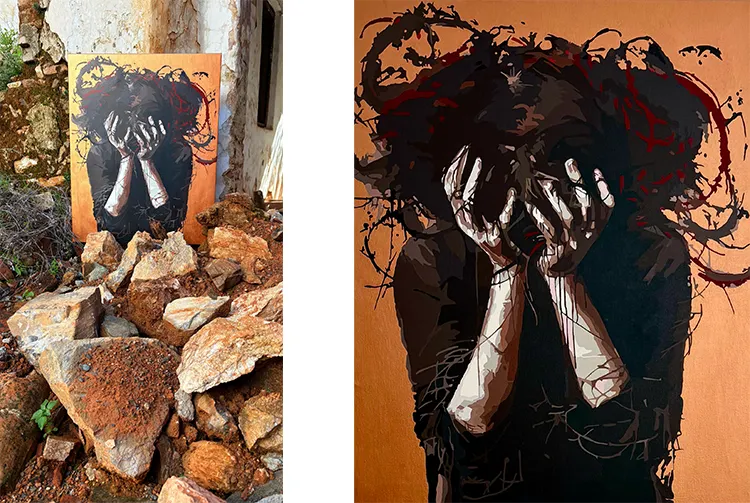
The Psychology of Color and Form
In her ongoing project In the Company of Sigmund Freud, Alisa Chernova constructs a psychological portrait of modern emotional distress through a compelling fusion of symbolism, color theory, and art therapy. Drawing from her academic foundation in medicine and her work in Gestalt psychology, she turns the canvas into a diagnostic tool, each stroke revealing suppressed fears and unspoken conflicts. The series includes works like Despair, Anxiety, and Deep Depression, each depicting different facets of emotional struggle. These paintings are not abstracted for abstraction’s sake; they are methodical attempts to communicate the unseeable. For example, Depression uses fragmented figures and dim palettes to depict the paralysis of mental exhaustion, capturing the eerie stillness that often defines this condition.
Chernova views her creative practice as an extension of therapeutic dialogue. Rather than speaking through language, she invites viewers to engage visually with the emotional narratives encoded in her compositions. Her artistic choices—such as the juxtaposition of dense textures with stark voids—are guided by an understanding of how the subconscious communicates through images and color. Each hue carries psychological weight: deep blues may evoke isolation, while crimson can signify suppressed rage or latent passion. Through these carefully chosen palettes, Chernova encourages a confrontation with uncomfortable emotions, fostering an environment in which catharsis is possible without words.
The artist is unwavering in her belief that acknowledging pain is the first step toward transformation. Art, in her hands, becomes more than an aesthetic endeavor; it is a process of psychological recovery. This philosophy permeates not only her individual works but her larger trajectory as a painter and art therapist. Her exhibitions across global venues—from Toronto and Tokyo to upcoming showcases in London and San Francisco—demonstrate the resonance of her approach. Audiences are drawn to the emotional sincerity of her work, finding echoes of their own internal landscapes mirrored in her canvases. Through this intersection of science, therapy, and creative expression, Alisa Chernova challenges us to view art not just as a mirror, but as a means of emotional recalibration.
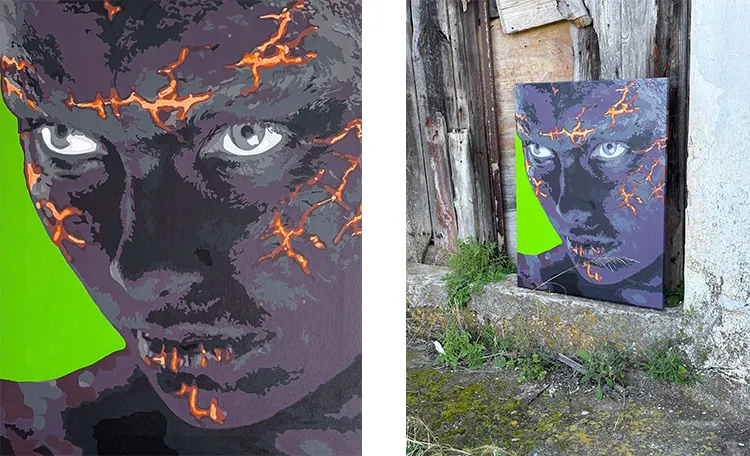
Who Am I? Monologue with Myself
One of her most resonant pieces to date, Who Am I? Monologue with Myself, reflects the silent dialogue each person holds within. It explores the fragile balance between identity and illusion, where cracks of uncertainty become spaces through which light can enter. Rather than offering direct answers, the work invites contemplation—a meditation on selfhood and the quiet strength found in vulnerability. Currently featured in Tokyo during the International Art Fair, the painting has found meaningful relevance with audiences engaged in themes of introspection and philosophical inquiry. It will also be presented at Red Dot Miami during Art Basel Week, continuing its journey as a conduit for reflection and emotional resonance.



